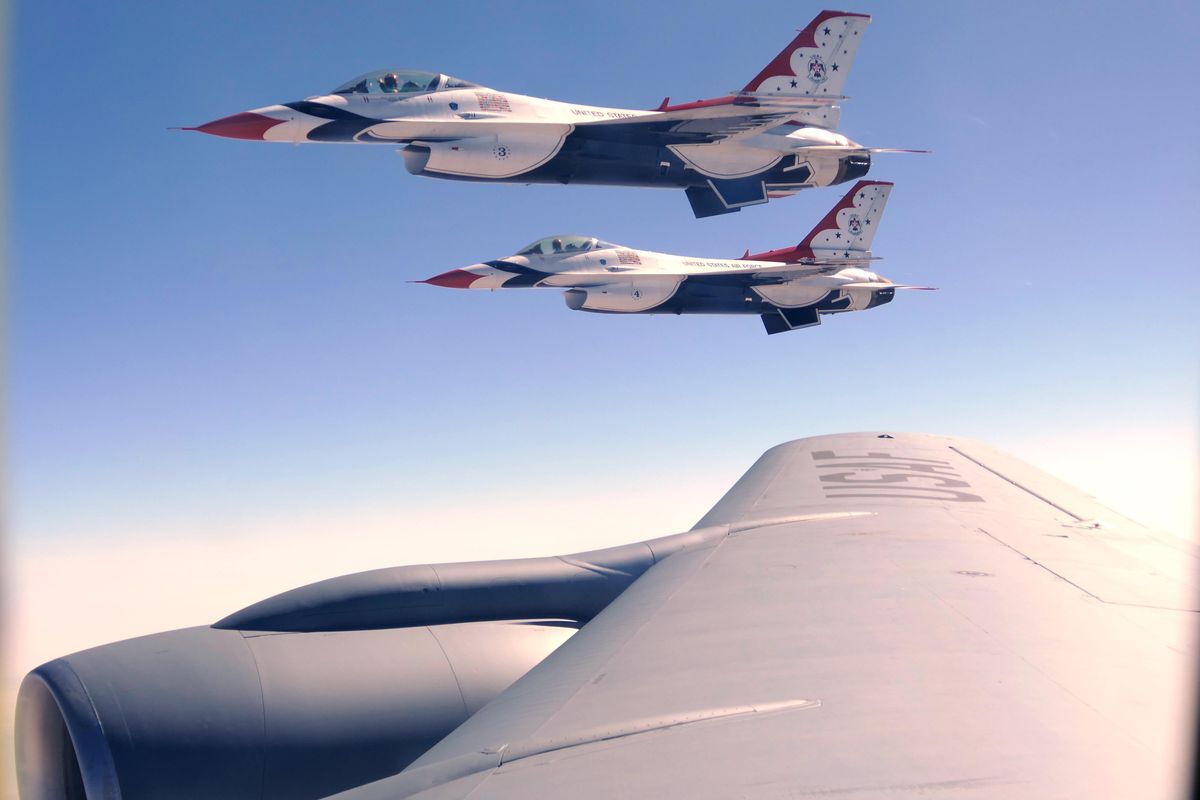At 30,000 feet and 300 miles per hour, Air Force breezes through midair refueling

You’d think that lying on your belly at the butt-end of a huge jet looking out a window in the floor straight to the ground 28,000 feet below would elicit terror.
But, strangely, it doesn’t. Not for first-timers, and not for Staff Sgt. Travis Peirce, a 25-year-old boom operator on a KC-135 Stratotanker, the gas station of the sky for the U.S. Air Force.
“Sometimes I think I have the easiest job in the world,” Peirce said Thursday during a refueling mission high above the eastern Nevada desert.
The plan: fly south to an area near Salt Lake City and rendezvous with eight F-16s, fighter jets in the Air Force’s demonstration squadron, the Thunderbirds. Once in contact, reverse course, noses pointed toward Boise, and refuel the fighter jets midair on their way to an airshow this weekend. Finally, touch down at Fairchild Air Force Base, home to more than 30 KC-135s, in time for lunch.
Easy enough.
For the assembled journalists aboard from nearly every news outlet in the region, it wasn’t exactly a difficult trip. But it didn’t look that easy.
We’d been in the air for over an hour when, just before 11 a.m., the Thunderbirds appeared, seemingly unannounced and out of nowhere. We scurried to the four windows in the fuselage with our smartphones, digital cameras and, in one case on one shoulder, a TV camera. KXLY’s Aaron Luna paced the plane with a selfie stick.
The jets lined up along the wings, holding steady to our line. Every few minutes, one would peel away and fade back, its turn at the pump.
Peirce kept cool on his belly in the back, his head on a chin rest, his eyes out the window and his hand on a joystick.
His vessel this day came off the Boeing assembly line in 1962. You can feel its vintage, even though every KC-135 in military service is stripped down to every bolt and paint speck and rebuilt every five years. Grab the joystick that controls the boom, and you can feel the pre-circuit board technology. Crank the stick to the left, and like a clumsy appendage, the gangly boom swings left.
The big vessel can carry up to 200,000 pounds of fuel beyond its own supply, deliverable at rates as high as 6,000 pounds per minute.
At nearly 30,000 feet, going 273 knots, inside a $40 million aircraft with another $15 million nosing up, it’s a wonder how Peirce and others in his post can keep calm.
“It looks complicated, but it’s just a bunch of lights,” he said of the array of gauges around him.
The No. 6 jet pulls up, with Maj. Whit Collins in the cockpit. With ease, Peirce connects the boom to the F-16’s mid-spine. For a minute, maybe two, the big and small aircraft are joined, swaying together in the high, thin air at not quite supersonic speeds.
Then, disconnection, marked by a small spritz of jet fuel, and Collins banks off port-side.
Not 25 minutes after they appeared out of nowhere, the Thunderbirds sped away, impatient to meet their Canadian counterparts, the Snowbirds, in Boise.
In the cockpit, Capt. David Leibrand and 1st Lt. Adam Less watch the sky and occasionally fine-tune a control. It’s hour four of a five-hour flight.
The sky was filled with cumulus clouds struck with the odd gray streak here and there, though most sat lower than us. Leibrand, the pilot, pulled a peanut butter and jelly sandwich from his bag and ate his lunch, enjoying the view.
“Look at the hills down there,” said Airman First Class Nicholas Kelly, another boom operator on the flight. “It never gets old.”
Unlike some of the military technology filling the cockpit. An old altimeter unwinding itself as we made our way down. Oil pressure gauges with 1950s-style type font. Still more gauges showing oil pressure, and the “angle of attack.”
The cockpit’s ceiling still has a sextant porthole, a golf ball-size aperture that can be opened for celestial navigation. We marveled at it, but didn’t need it. The crew looked continually to computer tablets showing our location on a map. And those worked just fine.